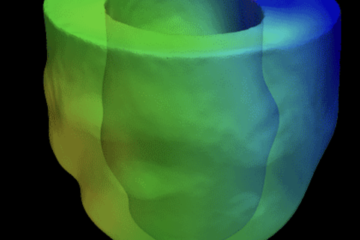Trayanova Lab’s and JHMI Digital Twin Research Featured in Wall Street Journal
Trayanova Lab’s and JHMI Digital Twin Research Featured in Wall Street Journal
On March 16th, the Wall Street Journal featured Dr. Trayanova and her lab’s work with JHMI on “digital twins” of people’s hearts– a method of creating a patient-specific model to study electrical problems and potentially guide therapy in a clinical environment. (article here, archive copy with no paywall here)
“In the Johns Hopkins clinical trial on heart arrhythmia, the patients undergo a cardiac contrast-enhanced MRI. From the images, the biomedical engineering team reconstructs a three-dimensional model of the patient’s heart, using artificial intelligence to put images together. The result is a 3-D heart that shows scarring and areas of damaged cells that can be rotated on the screen and looked at from different angles.
The digital heart is then populated with virtual cells that can each generate an electrical signal.
The team can then simulate a heartbeat in the heart digital twin, and poke and prod it by giving it small electrical signals here and there to see what happens with the heartbeat.
Using the digital twin, the team can predict the possible locations of disordered rhythms and identify the best locations for ablation before the procedure is carried out, says Trayanova, who is also a professor of medicine.”
The clinical team at JHMI was instrumental in making this research happen. Drs Calkins, Spragg, Marine, Sinha, and Chrispin have performed procedures guided by the digital twin models. From the WSJ article, “Researchers say it is also hard to move ahead because the concept involves so much agreement and buy-in from various stakeholders, including data scientists, doctors, engineers and others.
‘There is a lot of trust that needs to happen,’ says Dr. David Spragg, an associate professor of medicine at Johns Hopkins Hospital in Baltimore specializing in cardiology and cardiac electrophysiology.” By carrying out this trial, the team is working to build the requisite validation and trust.

